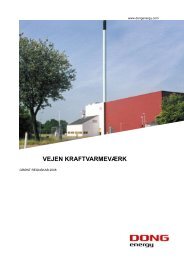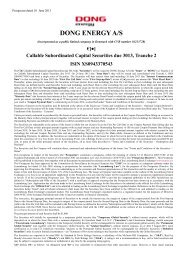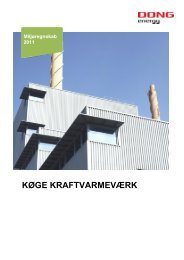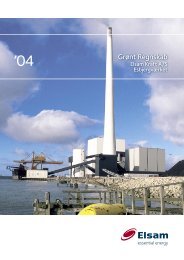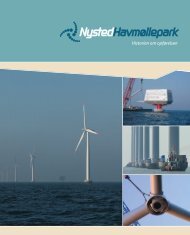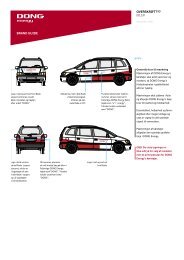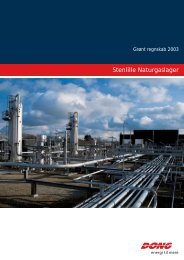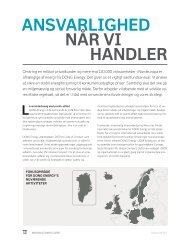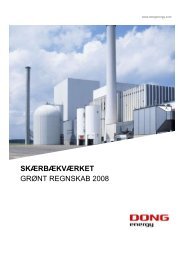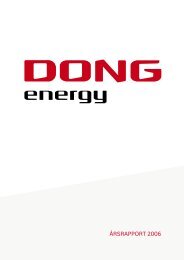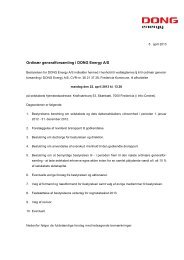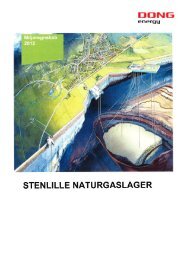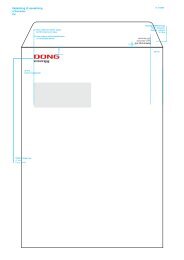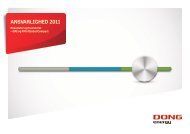ANNUAL REPORT 2011 - DONG Energy
ANNUAL REPORT 2011 - DONG Energy
ANNUAL REPORT 2011 - DONG Energy
Create successful ePaper yourself
Turn your PDF publications into a flip-book with our unique Google optimized e-Paper software.
CO 2 emissions allowances<br />
Allocated and purchased CO 2 emissions allowances, including<br />
CO 2 credits, that are accounted for as rights are measured ini-<br />
tially at cost. If a grant is received in connection with an allocation,<br />
the cost constitutes the actual consideration paid for the<br />
allowances, i.e. nil if the allowances are allocated free of charge.<br />
CO2 emissions allowances are not amortised, as their residual<br />
value equals their cost.<br />
rights<br />
Rights comprise gas purchase rights, acquired customer rights<br />
and IT software licences, etc., and are measured at cost less accumulated<br />
amortisation and impairment losses.<br />
Gas purchase rights are amortised using the unit-of-production<br />
method, taking into account the expected earnings profile, so<br />
that the amortisation pattern reflects the expected earnings<br />
patterns. Other rights are amortised on a straight-line basis<br />
over their expected economic lives, which are determined on<br />
the basis of management’s experience of the specific business<br />
areas, and the assets to which the rights relate. Capitalised<br />
rights are estimated to have a life of 5 - 20 years.<br />
Development projects<br />
Development projects that are clearly defined and identifiable,<br />
and for which technical feasibility, adequate resources and a<br />
future application in the enterprise can be demonstrated, and<br />
which the enterprise intends to manufacture or use, are recognised<br />
within intangible assets if the cost can be determined<br />
reliably and if there is reasonable certainty that the future<br />
earnings will cover all costs. Other development costs are recognised<br />
in profit for the year as incurred.<br />
Capitalised development costs are measured at cost less accumulated<br />
amortisation and impairment losses. Cost comprises<br />
wages and salaries and other costs attributable to the Group’s<br />
development activities. Borrowing costs relating to specific and<br />
general borrowing directly attributable to the development of<br />
development projects are recognised in cost.<br />
On completion of the development work, development projects<br />
are amortised on a straight-line basis over the estimated economic<br />
life from the date the asset is available for use. The amortisation<br />
period is usually five years. The basis of amortisation<br />
is reduced by any impairment losses.<br />
investments in associates<br />
Investments in associates are measured in the consolidated<br />
financial statements using the equity method whereby the<br />
investments are measured in the balance sheet at the proportionate<br />
share of the associates’ net assets determined in<br />
accordance with the Group’s accounting policies, increased by<br />
or net of the proportionate share of unrealised intragroup gains<br />
and losses and increased by any excess of cost on acquisition,<br />
including goodwill.<br />
Associates with negative net assets are measured at nil. If the<br />
Group has a legal or constructive obligation to cover the associate’s<br />
deficit, the obligation is recognised as a liability.<br />
Receivables from associates are measured at amortised cost.<br />
Write-downs are made for bad debts.<br />
On acquisition of investments in associates, the purchase<br />
method is applied, see the description under business<br />
combinations.<br />
Other equity investments<br />
Other equity investments comprise unlisted securities. Other<br />
equity investments are recognised initially in the balance<br />
sheet at cost, equivalent to fair value plus transaction costs.<br />
Subsequent to initial recognition, other equity investments are<br />
measured at cost less any impairment losses, as it is deemed<br />
impracticable to reliably determine their fair value.<br />
Other equity investments are recognised as financial assets<br />
available for sale. Available-for-sale financial assets are those<br />
non-derivative financial assets that are designated as available<br />
for sale or are not classified as loans and receivables, financial<br />
assets at fair value through profit for the year or held-to-maturity<br />
financial assets.<br />
Other non-current financial assets<br />
Other non-current financial assets comprise receivables that<br />
are recognised initially in the balance sheet at cost, equivalent<br />
to fair value, and are subsequently measured at amortised cost.<br />
inventories<br />
Inventories consist of oil and gas in storage facilities, as well<br />
as raw materials, consumables, fuel inventories, CO2 emissions<br />
allowances and green certificates.<br />
In the case of oil, cost is determined as the average production<br />
cost. In the case of gas, cost is determined as a weighted average<br />
of the previous month’s buying prices, including transportation<br />
costs.<br />
Allocated and purchased CO 2 emissions allowances that form<br />
part of the Group’s trading activities with a view to generating<br />
gains from short-term price fluctuations are measured at fair<br />
value with value adjustments recognised in profit for the year.<br />
<strong>DONG</strong> ENERGY <strong>ANNUAL</strong> <strong>REPORT</strong> <strong>2011</strong> – COnsOliDatED finanCial statEmEnts<br />
137<br />
notes



